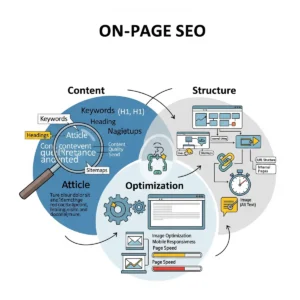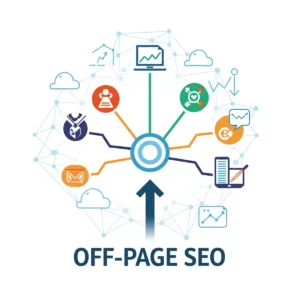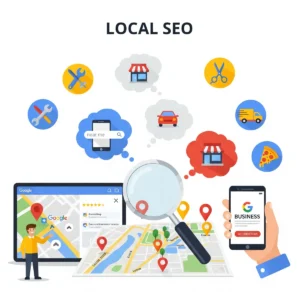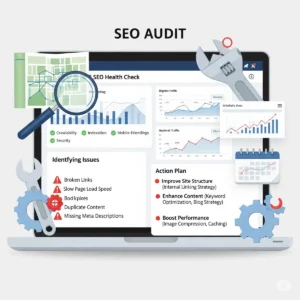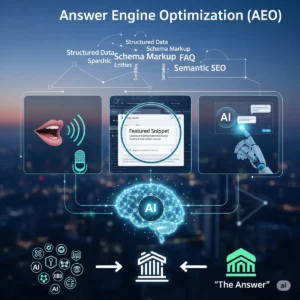What is Answer Engine Optimization?
From my own work in SEO, I’ve seen AEO become less about listing links and more about optimizing content so search platforms can directly provide answers to user queries without extra clicks. Whether it’s Google, Bing, or AI-powered chat results, the way answer engines deliver information—via featured snippets, voice assistant responses, or text-based search results—has changed how we approach rankings. The shift means adapting from traditional keyword-centric strategies to conversational, natural language targeting of specific, long-tail queries that mirror how people actually speak to voice assistants and AI chatbots. My goal when crafting in-depth content is to give the best direct answer upfront—explicit, concise, and factual—while ensuring a technical focus with standard technical SEO practices like crawlability, mobile-friendly design, page speed, meta tags, and Schema.org markup for structured data so AI extraction works flawlessly.
- Primary platforms like Google and Bing now favor answer-focused results.
- Use in-depth content that targets specific, long-tail queries with natural language.
- Prioritize featured snippets, voice assistant responses, and AI-powered chat results.
- Apply technical SEO fundamentals—crawlability, page speed, meta tags, and mobile-friendly layouts.
- Implement structured data with Schema.org markup for better AI extraction and Knowledge Graph inclusion.
- Track key metrics like rankings, CTR, organic traffic, backlinks, conversions, and brand mentions.
- Boost voice search share, featured snippet count, and referral traffic for wider online visibility.
- Maintain a solid SEO foundation as the prerequisite for effective AEO.
- Enhance user engagement through explicit, concise, factual answers delivered upfront.
- Use complementary tactics to strengthen positioning in search engine results pages and answer engines.

Why AEO Is Critical Now
Changing User Behavior
From my experience in search optimization, I’ve seen how users today expect quick, concise answers—they don’t want to spend time sifting through multiple webpages. Google even notes that 15% of searches each day are completely new queries, often longer, conversational questions. This shift means searchers increasingly prefer the immediate answer over traditional browsing.
- Users want quick, concise answers.
- Google sees 15% new queries each day.
- Many are longer, conversational questions.
- Searchers now prefer an immediate answer.
Zero-Click Searches Dominate
In recent years, analysis has found that nearly half of Google searches end without the user clicking a traditional result link. In fact, almost 65% click nothing because the answer is given directly on the results page through featured content, meaning some sites entirely miss out on valuable visibility.
- Half of Google searches now end without a click.
- Analysis shows nearly 65% skip clicking any link.
- Answer often given directly via featured content.
- Many sites entirely miss critical visibility.
AI-Driven Search Explosion
Just last week, reports showed 400 million people using OpenAI ChatGPT and related products for information. Microsoft saw a 4× increase in Bing mobile app downloads after introducing AI chat features. Gartner predicts that by 2026, 25% of organic search traffic will shift to chatbots and virtual assistants, reducing traditional clicks dramatically.
- 400 million people now use ChatGPT and related tools.
- Bing mobile app saw 4× more downloads.
- 25% of organic traffic will shift to chatbots/assistants by 2026.
- Fewer traditional clicks as AI search grows.
Voice Search Growth
Voice queries continue to grow as smart speakers and mobile assistants become central to commerce, with spending projected to reach $80 billion in annual value. This surge brings significant interactions between businesses and searches, often using natural, question-like phrasing that requires entirely different optimization approaches.
- Voice queries are rapidly growing worldwide.
- Smart speakers & mobile assistants drive commerce.
- Spending to reach $80 billion annual value.
- Needs different SEO for question-like phrasing.
Business Impact – Traffic vs. Engagement
With AEO, there may be fewer direct clicks, but it can still drive brand engagement and conversions in subtler ways. Stack Overflow saw an 18% drop in visits as ChatGPT became popular for developers seeking code answers from AI, while NerdWallet experienced 35% growth in revenue despite a 20% decrease in site traffic—proving content and expertise still attract consumers through snippets and other channels.
- AEO can cut direct clicks but boost engagement.
- Stack Overflow lost 18% visits due to ChatGPT usage.
- NerdWallet saw 35% revenue growth despite less traffic.
- Strong content & expertise win via snippets/channels.
How AEO Works
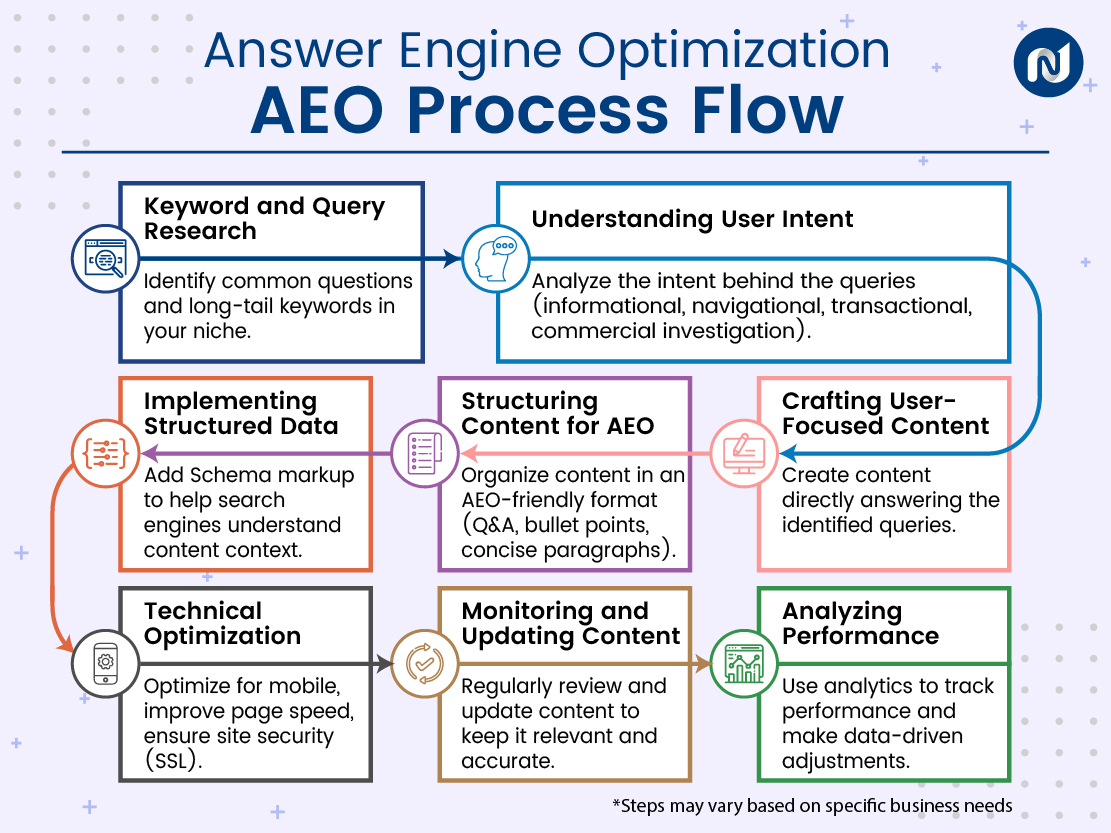
Natural Language Processing and User Intent
Answer engines now use NLP to interpret the context and intent of a query, going beyond simple matching of keywords to truly understand the nuances of human language. For example, knowing that “how to start a garden” can involve multiple sub-questions, they still aim to deliver a single, factual answer that satisfies the user instantly.
- NLP helps answer engines read context & intent.
- Goes beyond matching keywords to understand language.
- Example: “how to start a garden” = multiple sub-questions.
- Delivers single, factual answer quickly.
The Role of AI and Machine Learning
Modern answer engines leverage machine learning models trained on vast datasets to interpret and respond more accurately. Google uses BERT and MUM, while Bing has integrated OpenAI GPT-4 to tap into AI capable of analyzing huge portions of the web, detecting language patterns, and pulling factual information to generate precise answers.
- Answer engines rely on machine learning & AI.
- Google uses BERT and MUM; Bing uses GPT-4.
- Trained on vast datasets from huge portions of the web.
- Finds language patterns to generate factual answers.
Structured Data and Knowledge Graphs
Answer engines often rely on structured data, with Google’s Knowledge Graph pulling facts from trusted sources to directly respond to queries. Using schema markup on your site for FAQs, how-tos, and products can increase your chances of having search engines interpret and present your content as the featured answer.
- Structured data powers answer engines.
- Google Knowledge Graph aggregates facts from trusted sources.
- Schema markup for FAQs, how-tos, and products boosts visibility.
- Helps search present your content as the answer.
Strategies for Effective AEO
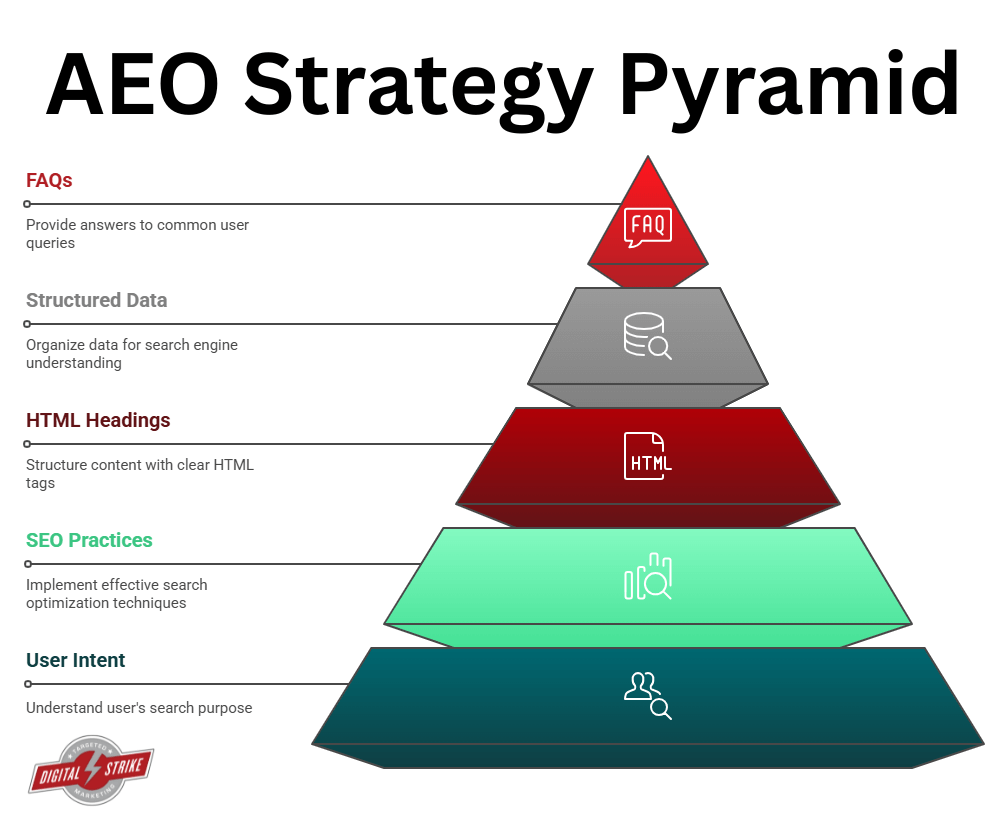
1. Understand User Intent and Think in Questions
To excel in AEO, start by understanding user intent and thinking in questions your target audience is asking. I rely on tools like Google People Also Ask boxes, Answer the Public, BuzzSumo, Question Analyzer, and SEMrush Topic Research for researching and identifying the actual search queries your site’s visitors use. By analyzing and organizing these key questions around topic intent, you can create a content strategy that truly addresses user needs at every stage of their journey.
- Use tools to find what questions your audience asks.
- Explore Google People Also Ask and Answer the Public for insights.
- Analyze and organize queries by topic intent.
- Build a content strategy that matches user needs precisely.
2. Optimize Content Format for Direct Answers
To optimize content format for direct answers, focus on making your content clear and easy for both humans and machines to parse. Use a question-and-answer structure with explicit questions as headings and concise, upfront answers of 40-60 words at the beginning of each relevant section. Break information into digestible chunks using H2s, H3s, and bullet points. Include FAQ or dedicated pages for common, related topics. Keep content accurate, fresh, and authoritative to meet what answer engines favor.
- Use question-and-answer format with clear headings.
- Provide concise, direct answers (40-60 words) upfront.
- Organize info in H2s, H3s, and bullet points.
- Maintain accuracy, freshness, and authority for best results.
3. Technical SEO and Schema Markup for AEO
To strengthen AEO efforts, technical SEO must follow best practices focusing on structure, metadata, and crawlability. Ensure your site is accessible to crawlers and loads quickly for optimal performance. Implement structured data using Schema.org with relevant schema types like FAQPage for question-answer pairs, HowTo for guides, Article for main content, and Speakable for voice search. Include LocalBusiness schema with detailed business info. Optimize meta tags—title, description, and use clear internal links to connect related content logically. Provide accurate, clear, and unambiguous information units with specificity to improve answer quality.
- Follow technical SEO best practices for crawlability and speed.
- Use Schema.org structured data like FAQPage, HowTo, Article, Speakable.
- Add LocalBusiness schema for detailed business info.
- Optimize meta tags and internal linking with clear, specific info.
4. Off-Site Presence and Authority Building
Building strong AEO results isn’t just about on-page work—off-site factors play a crucial role. Answer engines favor credible content and business listings properly optimized and listed on key platforms with accurate information. Encouraging reviews and testimonials signals trust. Additionally, authoritative backlinks from trusted sources boost your SEO authority and E-A-T (Expertise, Authority, Trust). Showcasing your brand, personal expertise, credentials, and getting mentions in reputable publications and subject-matter sites further strengthens your online presence.
- Off-site factors are vital alongside on-page AEO efforts.
- Optimize and maintain accurate business listings on key platforms.
- Gain reviews, testimonials, and authoritative backlinks.
- Build SEO authority with strong E-A-T and reputable mentions.
5. Monitor, Test, and Refine
Measuring AEO success requires approaches beyond traditional SEO, including tracking featured snippets, People Also Ask, and using tools like Semrush, Ahrefs, Moz, and Search Console. Regularly monitor impressions, clicks, and queries to identify signs your content is appearing in answer engines. It’s important to manually test with Google, voice assistants, and AI chatbots. Use specialized tracking tools like OmniSEO to follow mentions across platforms. Continuously optimize, iterate, and test changes based on hypotheses to improve visibility, conversions, and the indirect paths where users might hear your brand before they visit directly.
- Track featured snippets, People Also Ask, and key queries.
- Use SEO tools like Semrush, Ahrefs, Moz, and Search Console.
- Manually test on Google, voice assistants, and AI chatbots.
- Optimize and iterate to boost visibility and conversions.
Why AEO Matters in Today’s Search Landscape
Studies show that 50% of searches now end in zero clicks, as users get answers directly in search results or via voice. With 20% of mobile queries answered by AI-powered tools, AEO has become essential. It marks the evolution—not the death—of traditional SEO, requiring a more comprehensive optimization strategy for emerging answer engines.

Real-World Success Stories
Real-World Success Stories demonstrate how search is evolving rapidly. Studies reveal that 50% of searches end with zero clicks because users receive answers directly in search results or through voice assistants. Around 20% of mobile queries are handled by AI-powered tools, now mainstream in the search landscape. This shift signals the evolution, not the death, of traditional SEO, pushing businesses to adopt a comprehensive optimization strategy that targets emerging answer engines.
- 50% of searches result in zero clicks as answers appear instantly.
- Users increasingly rely on voice and AI-powered tools for quick answers.
- 20% of mobile queries are answered by AI-driven platforms.
- This marks an evolution requiring new, comprehensive SEO strategies.
The Future of AEO
Looking ahead, the future of AEO involves greater personalization and sophistication as answer engines advance with AI and machine learning models. They will deliver tailored responses based on different users’ context and past behavior. The rise of voice search will blend with emerging technologies like AR on devices such as cars with built-in assistants, providing seamless information and integrating with business systems to perform actions like booking, reservation, or placing orders. To stay ahead, businesses must prepare the correct content and focus on smooth integration.
- AI and machine learning models will make answers highly personalized.
- Voice search will merge with AR and smart devices like cars.
- Assistants will integrate with business systems to perform actions.
- Businesses need to optimize content and system integration for the future.
Why AEO Doesn’t Replace SEO But Changes How We Approach It
The Synergistic Relationship
A solid SEO foundation combined with AI-powered optimization is key to thriving in AEO.
- Strong domain authority builds trust as a reliable answer source.
- High-quality, mobile-friendly content enhances user experience.
- Effective backlink profiles boost credibility and rankings.
- AI improves featured snippets, click-through rates, and voice search traffic.
The Evolution, Not Revolution
AEO is not replacing SEO but rather its natural evolution, shifting from traditional methods like keyword density, exact match, and link quantity to focusing on user intent, content quality, and technical excellence. The modern approach embraces conversational AI, understanding, and multi-modal integration to meet the demands of today and the future.
- AEO is an evolution, not a replacement, of SEO.
- Moves beyond keyword and link quantity to user intent.
- Emphasizes content quality and technical excellence.
- Integrates conversational AI and multi-modal search understanding.
Why Both Strategies Are Essential
Users show varied behaviors: traditional search suits research-intensive, complex queries like detailed product comparisons and in-depth, educational content, while AEO excels at providing immediate, quick, factual answers for simple, how-to, and voice searches during multitasking or mobile, on-the-go moments. Modern customer journeys involve multiple touchpoints and interactions, where initial basic info via AEO and detailed research via traditional SEO both drive return visits and satisfy specific user details.
- Traditional SEO supports complex, research-intensive queries.
- AEO provides quick, factual answers for simple, voice searches.
- Users multitask on mobile, needing immediate info and depth.
- Both strategies cater to different stages of the customer journey.
Future-Proofing Your Search Strategy
To succeed in 2025 and beyond, adopt an integrated optimization approach that combines SEO and AEO. Create comprehensive content that serves multiple formats, optimizing for both traditional keywords and conversational queries. Focus on building authority through link building and answer selection, while continuously monitoring performance in AI-powered results. Success comes from adaptability, specialization, and a willingness to evolve with technology advancements.
- Integrate SEO and AEO for a complete strategy.
- Optimize content for both traditional and conversational queries.
- Build authority with strong link building and answer-focused content.
- Monitor and adapt to changes in AI-powered search results.
Advanced Strategies for SEO and AEO Integration

Content Optimization Techniques
Effective content optimization combines traditional SEO with AEO-focused strategies to reach diverse search preferences.
- Use the hub and spoke model to organize comprehensive content.
- Target both competitive keywords and AEO-specific queries.
- Incorporate FAQ, how-to, and quick answer formats for clarity.
- Create multi-format assets like videos, infographics, and podcasts.
Technical Implementation
Advanced schema markup and structured data implementation are key to maximizing search visibility and performance.
- Use nested FAQ, article, and how-to schemas with step-by-step instructions.
- Add video chapter markers and detailed product specifications.
- Focus on core web vitals, speed, and mobile-first indexing.
- Ensure progressive app compliance for optimal device compatibility.
Measurement and Analytics
An integrated tracking strategy is essential to effectively monitor both SEO and AEO performance. Key metrics include traditional organic traffic, keyword rankings, backlink acquisition, and page load speeds, alongside featured snippet captures, voice search visibility, answer box appearances, and zero-click search performance.
- Track organic traffic growth and keyword rankings.
- Monitor backlink acquisition and page load speeds.
- Measure featured snippet and answer box appearances.
- Analyze voice search and zero-click search effectiveness.
Essential Tools for Your AEO Toolkit
Essential tools help streamline your AEO process, from question research to technical optimization and performance tracking.
- AnswerThePublic, AlsoAsked, Google Trends, SEMrush Keyword Magic Tool
- Ahrefs Keywords Explorer, Surfer SEO, Clearscope for content optimization
- Search Console, Rich Results Test, Schema.org markup generators
- Accuranker, AI simulators like Perplexity.ai, ChatGPT Browse for analytics and insights
Conclusion
In summary, mastering Answer Engine Optimization (AEO) is essential for staying competitive in today’s evolving search landscape, where direct, concise answers drive user engagement and visibility. As we look toward the future, integrating AEO with traditional SEO tactics—including insights from experts like Semantic SEO Speaker Ben Stace and applying Cutting-Edge On-Page SEO Tactics for 2025—will be key to success. Staying informed with the latest developments such as Generative Engine Optimization (GEO) News 2025 and understanding factors like How Much Does Search Engine Optimization (SEO) Cost in the UK will empower businesses to optimize their strategies effectively and maximize ROI.
Get Free SEO Audit
FAQs Releated to AEO Question Optimization Best Practices: The Complete 2025 Guide
How to optimize for AEO?
To optimize for AEO, focus on targeting specific questions and providing concise, clear answers. Use structured data like FAQs, how-to guides, and optimize for featured snippets and voice search. Continuously improve content quality to enhance visibility and ranking.
What is AEO vs SEO?
AEO (Answer Engine Optimization) focuses on providing direct answers through featured snippets, knowledge panels, and voice responses, prioritizing quick, precise information delivery. In contrast, SEO (Search Engine Optimization) aims to improve website ranking on search engine results pages (SERPs) to drive more traffic. Both are key digital marketing strategies with the primary goal of increasing visibility, but AEO targets answer engines while SEO focuses on traditional search ranking.
How to optimize content for AEO?
To optimize content for AEO, focus on answer engine optimization tips and best practices by using simple, unique terms and text that address long-tail questions. Implement schema markup and include FAQs to help search engines understand your content better. Support your answers with accurate facts and figures for credibility and relevance.
What is the full form of AEO optimization?
The full form of AEO is Answer Engine Optimization, which is the practice of optimizing content for search platforms that directly provide answers to user queries, often by listing answers instead of just links.
Is AEO better than SEO?
AEO complements traditional SEO by focusing on immediate retrieval of structured content through featured snippets, knowledge panels, and voice search results, while SEO targets broader ranking of web pages. Both work together to enhance visibility, but AEO excels in providing quick, direct answers.
What is the purpose of AEO?
The purpose of AEO (Authorized Economic Operator) is to serve as an internationally recognized quality mark that certifies an entity in the supply chain as efficient, compliant, and secure in customs procedures and clearances.

